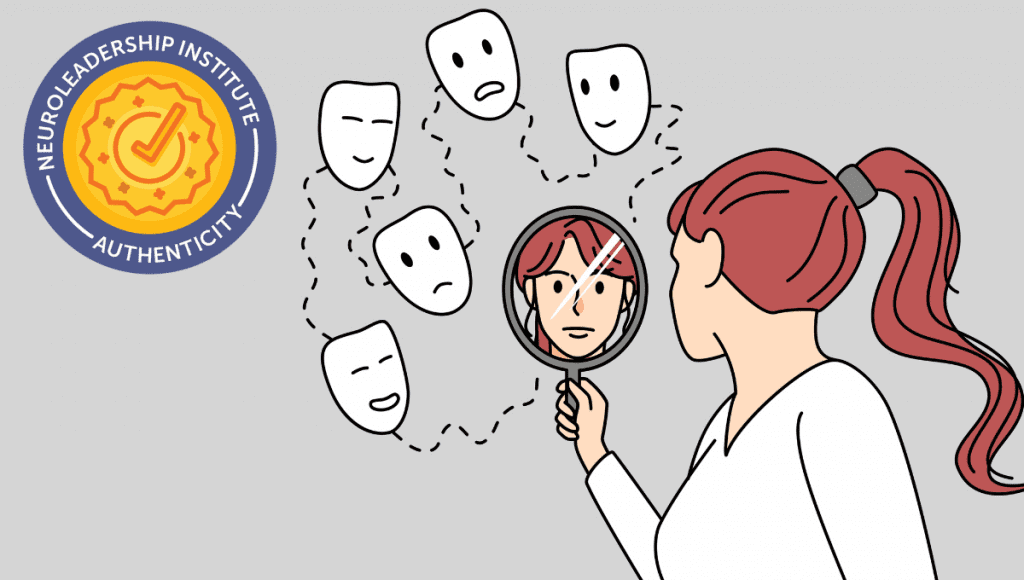Stefan, a sales manager at a software company, was up most of the night taking care of his toddler, who’s sick with the flu. When Stefan shows up at the office the next morning, bleary-eyed and running on fumes, he’s tired and not as sharp as usual.
In the old days, Stefan would’ve had to suck it up, even if that meant putting on an act and pretending everything was normal. But times have changed. Today, recognizing the benefits of authenticity, organizations have begun encouraging employees to be open about their needs and struggles. As The Economist puts it, authenticity means “employees need not pretend to be someone they aren’t. Instead of having a workplace persona and a non-workplace persona, people can just relax and always be themselves.”
Being authentic isn’t easy. It means being vulnerable, taking risks, and talking openly about your weaknesses. Instead of always trying to put your best foot forward and fake it till you make it, it means letting others know you’re only human.
The rules are changing, and it’s not always clear how to bring your whole self to work without going too far or crossing the line. So how do you know what’s oversharing and what’s appropriate? Here are a few principles to navigate authenticity at work.
Normalize talking about stress, sleep, and capacity
In the old days, being “professional” meant papering over individuality and human frailty: “We’re here to get a job done.” Work wasn’t a place to display your real personality. Employees were expected to conform, keep their head down, and get their work done without complaining, and it was taboo to talk openly about struggles with sleep, mental health, or burnout.
Today, organizations understand that human beings aren’t machines, and the brain’s cognitive capacity is powerfully affected by sleep, stress, and downtime. Which means that if one of those factors is interfering with your ability to do your job, that conversation is relevant to work.
Being open about these things doesn’t give you permission to slack off when you don’t feel like working. What it does mean is that when something beyond your control is affecting your ability to perform, you no longer have to pretend. Stefan, for example, can open the sales meeting by telling his team, “I’m not at my best today. I was up most of the night with a sick child.”
Be vulnerable
Today, organizations recognize that enforcing a rigid social hierarchy — and hiring authoritarian, inaccessible managers who give orders and rule through fear — hinders employee performance and slashes retention.
Leaders play a significant role in building trust and relatedness and helping cultivate an environment of psychological safety — one where employees feel safe to speak up without fear of repercussions. To do that, managers need to model vulnerability themselves by admitting weakness and sharing their mistakes.
When we talk openly about our own weaknesses, it makes us more relatable, helping build trust and social connection with others. It also reminds employees they don’t have to be perfect — they just need to do their best and keep learning.
Similarly, when leaders admit mistakes, it normalizes imperfection for other employees, making people feel safe to try new ways of doing things in the spirit of experimentation and growth mindset. NLI, for example, runs a “mistake of the month” contest during its monthly all-hands meetings to help model and encourage a mindset of innovation and experimentation.
Sharing your own mistakes as a leader doesn’t mean you’re giving employees permission to be sloppy or inattentive. It just means you’re normalizing the fact that everyone makes mistakes. By saying something like, “Calling the client by the wrong name made me realize I need to slow down and give important tasks the time and attention they deserve,” sends a powerful message throughout the organization that mistakes are opportunities to reflect and learn.
Don’t confuse identity with behavior
No matter what your role, no one has the right to tell you that who you are is wrong. This includes protected classes, such as race, ethnicity, gender identity, sexual orientation, disability status, and nation of origin, as well as other aspects of your identity, such as your accent, the neighborhood you grew up in, or the generation you belong to.
But your identity is different from what you do when you’re at work. And being free to be who you are doesn’t automatically give you free rein to broadcast your political views, religious beliefs, or details of your love life. Whatever your identity, talking about sensitive topics at work is a behavior — one that may or may not be appropriate in your organization.
Depending on where you work, your job may require you to speak, dress, or behave in specific ways — and authenticity doesn’t give you carte blanche to ignore those requirements. You might identify as a fan of glam metal, but that doesn’t mean you can show up to a major client meeting in ripped jeans, a Kiss wig, and demon makeup.
Remember, “bring your whole self to work” doesn’t mean you bring every aspect of your personality to the office. You’re still responsible for your performance — and if part of your job includes presenting a professional image to clients, it’s still on you to represent your organization in an appropriate manner.
Respect others
Being authentic at work also doesn’t mean you have no filter, or that you suddenly have the right to engage in behaviors that demean others. You still need to speak with respect for your peers and be aware of your environment.
Nor does authenticity mean you’re free to share every personal thought that comes to mind. As Pamela Paul writes in The New York Times, employees should “reserve their aches, [personal] grievances, flimsy excuses, and noisy opinions for the roommate, the pandemic puppy, and the houseplants.”
So how do you know what’s appropriate and what’s not? The key is to share with intention. Think about how your sharing will affect others and the purpose behind why you’re doing so. Are you sharing information about something that’s affecting your cognitive capacity? Disclosing a vulnerability or insecurity in order to connect with your employees? Or are you working through personal matters better reserved for friends and family?
Remember: A workplace is a community, and your desire to be authentic doesn’t supersede other people’s right to feel comfortable and safe at work.






